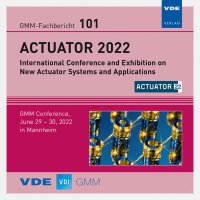Fatigue behavior of Shape Memory Alloy wires actuated at high speed
Konferenz: ACTUATOR 2022 - International Conference and Exhibition on New Actuator Systems and Applications
29.06.2022 - 30.06.2022 in Mannheim
Tagungsband: GMM-Fb. 101: ACTUATOR 2022
Seiten: 4Sprache: EnglischTyp: PDF
Autoren:
Citro, Marco; Coco, Salvatore (SAES Group, Lainate, Italy)
Inhalt:
Usually Shape Memory Alloys (SMA) are adopted in industrial applications in the shape of thin wires (diameter ˂ 0,5 mm) fed by less than 12-24 Volts. Such voltage level allows standard speed movement of the actuator [1]. The speed of those actuations depends on the wire diameter. The smaller is the wire diameter the faster is the response. The behaviour of thin Shape Memory Alloy wires actuated at standard speed is well known. With these actuators it is possible to achieve hundreds of thousands of fatigue cycles by setting the proper conditions (stress and strain). Such fatigue resistance is guaranteed also by using SMA wires for proportional actuations. Providing high voltages for few milliseconds leads to high activation speed. Several advantages have been reported in literature [2] [3] [4] but no informations about fatigue life endurance have been retrieved by the authors. The possibility of using the SMA wire at high speed for multiple actuations could open new opportunities as well as new ways of designing actuators for industrial applications. This work is aimed at investigating the possibility to use SMA wires actuated ad high speed also for applications that require fatigue endurance. Among this kind of applications examples are bistable mechanisms. The latter are characterized by two positions of stability and the need to switch between them without being proportional. Other examples could be the release mechanisms or similar applications in the safety field. A dedicated equipment has been designed in order to perform the SMA wire cycling at high speed. Such equipment allows the feeding of the wire both by capacitors and by a power supply and it can measure the displacement provided by the wire at constant load. The equipment can measure also the features of the feeding pulse (i.e. current, voltage, duration). No damping nor brakes have been introduced and it is possible to observe the rebounds depending on the speed of the actuation. To compare the fast actuation cycling with the standard one, several tests have been carried out by changing the stress and the stroke of the actuations. The tests have shown the possibility to use SMA wires also by pulse activation for hundreds of thousands of fatigue cycles by setting the proper conditions (stress and strain). On the other hand the same tests has shown the possibility to use SMA wires for high strain/ high stress condition for a very limited number of cycles (less than 10).


